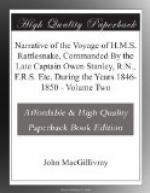That the Kowraregas settled the Prince of Wales Islands either prior to or nearly simultaneously, with the spreading downwards from New Guinea of the Papuans of the islands, scarcely admits of absolute proof: but that the former have existed as a tribe for a long period of years is shown by the changes which I presume to have taken place in their language. While this last unquestionably belongs to the Australian class, as clearly indicated by Dr. Latham’s analysis of the pronouns,* one of the characteristic parts of the language, and, therefore, least liable to change, yet the occurrence in the Kowrarega of a considerable number of words resembling and often identical with those of the known Papuan languages of Torres Strait,** and which I believe to have been derived from the latter, seems to indicate a degree of long-continued intercourse between the two races: for changes in language to so great an extent are not effected in a short space of time any more than the nearly complete fusion of two different races which has evidently taken place at the Prince of Wales Islands. Scarcely opposible to this supposition is the extreme improbability that the Papuans, who had nothing to gain from so comparatively inferior a race as the Australian, should be indebted to the latter for the words common to both found to exist in the Kowrarega and Miriam languages.
(Footnote. See the Appendix.)
(**Footnote. As means of comparison I used the Darnley and Murray Island vocabulary given in Jukes’ Voyage of the Fly, also a manuscript one of my own, which furnishes some additional particulars; some words from Massid given by Jukes; and a few from Mount Ernest procured by myself.)
Another mode of procedure suggests itself to one endeavouring to trace the proximate origin of the Australians—and that is, to search the records of voyagers and others for any traces of such customs, the use of certain implements, etc., as are supposed to be most characteristic of these people. Yet, taking, for example, the boomerang* and throwing-stick,** we find nothing approaching to either of these instruments in any part of New Guinea yet visited by Europeans: in the absence of any evidence to the contrary from Timor, they may be considered as true Australian inventions; and assuming the Australians to be the descendants of a colony from Timor, the circumstance of the natives of Melville Island—a part of Australia distant only




